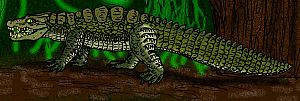Trilophosuchus facts for kids
Quick facts for kids TrilophosuchusTemporal range: Early-Middle Miocene
|
|
|---|---|
 |
|
| Scientific classification |
|
| Kingdom: | Animalia |
| Phylum: | Chordata |
| Class: | Reptilia |
| Order: | Crocodilia |
| Family: | Crocodylidae |
| Subfamily: | †Mekosuchinae |
| Genus: | †Trilophosuchus Willis, 1993 |
| Type species | |
| †Trilophosuchus rackhami Willis, 1993
|
|
Trilophosuchus (say "Try-LOH-foh-SOO-kus") means "Triple Crest Crocodile." It was an extinct type of crocodile that lived in Australia. Unlike today's crocodiles, scientists think Trilophosuchus lived mostly on land.
Trilophosuchus was about 1.5 metres (4.9 ft) long, which is roughly the size of a human teenager. It had a short head with three bumps, or "crests," on top. It also had big eyes. Fossils of Trilophosuchus have been found in Riversleigh, a famous fossil site in north-western Queensland, Australia. These fossils are from the Miocene period. So far, only one species, T. rackhami, has been found and named.
Contents
How Was Trilophosuchus Discovered?
Scientists found Trilophosuchus from a part of its skull. This special skull piece, called the holotype, is now kept at the Queensland Museum. Other small skull bones were also found.
These bones were dug up in 1985 at the Ringtail Site in Riversleigh. Riversleigh is one of Australia's most important fossil places. The University of New South Wales team found the skull. The rocks where Trilophosuchus was found are about 20 million years old.
In 1993, a scientist named Paul Willis officially named Trilophosuchus. He described the fossils in a science paper called the Journal of Vertebrate Paleontology.
What Did Trilophosuchus Look Like?
Trilophosuchus had a short, deep skull and pretty large eyes. Even though only its skull has been found, scientists guess it was about 1.5 metres (4.9 ft) long. Because it was small, Trilophosuchus looked a bit like today's dwarf crocodile (Osteolaemus) and some caimans (Paleosuchus).
It also looked like some older crocodile relatives. But Trilophosuchus was not closely related to these animals. It probably got its short snout and small body through convergent evolution. This means different animals can develop similar features if they live in similar ways.
Trilophosuchus had some special features that make it unique:
- A tooth from its lower jaw fit into a deep groove in its upper jaw.
- It had two openings in the roof of its mouth, called palatal fenestrae.
- The bones under its eyes stuck out, making ridges on the sides of its head.
- It had three ridges running along the top of its skull. This is how it got its name, "Triple Crest Crocodile."
The back of its skull had special shapes. These shapes show where muscles attached that helped Trilophosuchus hold its head up high.
How Is Trilophosuchus Related to Other Crocodiles?
Even though Trilophosuchus looked like some very old crocodile relatives, it was actually a more advanced type of crocodile. Scientists use special features to group animals together.
Trilophosuchus has a bone behind its eye that is tucked into its skull. This is a special feature of a group called Neosuchia. It also shares features with eusuchians, which include all living crocodiles.
At first, scientists thought Trilophosuchus was one of the earliest known mekosuchines. Mekosuchines are a group of crocodiles that lived in Australia and nearby islands. But later, older mekosuchines like Kambara were found.
Newer studies suggest Trilophosuchus was more advanced. It was more closely related to younger mekosuchines like Quinkana and Mekosuchus. Scientists now place it in a group called Mekosuchini.
How Did Trilophosuchus Live?
Trilophosuchus was part of a big group of mekosuchines that lived in Australia during the Cenozoic Era. Other mekosuchines living then included Pallimnarchus, Australosuchus, and Quinkana.
- Pallimnarchus and Australosuchus were wide-snouted, typical crocodiles.
- Quinkana had a deep snout and special teeth.
- Trilophosuchus was different because of its short, deep snout.
Most of these early Australian mekosuchines lived on land. This is different from most crocodiles today, which live in water.
It's hard to know exactly how Trilophosuchus lived. The living crocodiles that look most like it, Paleosuchus and Osteolaemus, live in water. But Trilophosuchus looks even more like older crocodile relatives that lived entirely on land.
When Trilophosuchus was first described, Paul Willis thought it lived on land. This is because most other extinct crocodile relatives with short snouts and eyes on the sides of their heads lived on land. Also, the way its neck muscles were shaped suggests it held its head high. This posture is better for an animal that lives on land, not in water.
Trilophosuchus probably moved more like a monitor lizard than a crocodile. Its short snout suggests it ate smaller prey. It might have eaten fish, turtles, snakes, and small mammals. All these animals have been found as fossils at Riversleigh. Its neck muscles might have helped it move its head quickly to catch food.
Some scientists have suggested that another small mekosuchine, Mekosuchus inexpectatus, might have lived in trees. Since Trilophosuchus looks similar, some thought it might have lived in trees too. However, there is no proof that Trilophosuchus could climb. So, not all scientists agree that it lived in trees.
Images for kids
See also
 In Spanish: Trilophosuchus para niños
In Spanish: Trilophosuchus para niños


